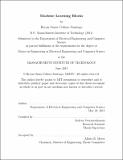| dc.contributor.advisor | Kalyan Veeramachaneni. | en_US |
| dc.contributor.author | Collazo Santiago, Bryan Omar | en_US |
| dc.contributor.other | Massachusetts Institute of Technology. Department of Electrical Engineering and Computer Science. | en_US |
| dc.date.accessioned | 2015-12-16T15:54:24Z | |
| dc.date.available | 2015-12-16T15:54:24Z | |
| dc.date.copyright | 2015 | en_US |
| dc.date.issued | 2015 | en_US |
| dc.identifier.uri | http://hdl.handle.net/1721.1/100301 | |
| dc.description | Thesis: M. Eng., Massachusetts Institute of Technology, Department of Electrical Engineering and Computer Science, 2015. | en_US |
| dc.description | This electronic version was submitted by the student author. The certified thesis is available in the Institute Archives and Special Collections. | en_US |
| dc.description | Cataloged from student-submitted PDF version of thesis. | en_US |
| dc.description | Includes bibliographical references. | en_US |
| dc.description.abstract | This work presents MLBlocks, a machine learning system that lets data scientists explore the space of modeling techniques in a very easy and efficient manner. We show how the system is very general in the sense that virtually any problem and dataset can be casted to use MLBlocks, and how it supports the exploration of Discriminative Modeling, Generative Modeling and the use of synthetic features to boost performance. MLBlocks is highly parameterizable, and some of its powerful features include the ease of formulating lead and lag experiments for time series data, its simple interface for automation, and its extensibility to additional modeling techniques. We show how we used MLBlocks to quickly get results for two very different realworld data science problems. In the first, we used time series data from Massive Open Online Courses to cast many lead and lag formulations of predicting student dropout. In the second, we used MLBlocks' Discriminative Modeling functionality to find the best-performing model for predicting the destination of a car given its past trajectories. This later functionality is self-optimizing and will find the best model by exploring a space of 11 classification algorithms with a combination of Multi-Armed Bandit strategies and Gaussian Process optimizations, all in a distributed fashion in the cloud. | en_US |
| dc.description.statementofresponsibility | by Bryan Omar Collazo Santiago. | en_US |
| dc.format.extent | 102 pages | en_US |
| dc.language.iso | eng | en_US |
| dc.publisher | Massachusetts Institute of Technology | en_US |
| dc.rights | M.I.T. theses are protected by copyright. They may be viewed from this source for any purpose, but reproduction or distribution in any format is prohibited without written permission. See provided URL for inquiries about permission. | en_US |
| dc.rights.uri | http://dspace.mit.edu/handle/1721.1/7582 | en_US |
| dc.subject | Electrical Engineering and Computer Science. | en_US |
| dc.title | Machine learning blocks | en_US |
| dc.type | Thesis | en_US |
| dc.description.degree | M. Eng. | en_US |
| dc.contributor.department | Massachusetts Institute of Technology. Department of Electrical Engineering and Computer Science | |
| dc.identifier.oclc | 930710211 | en_US |
